Rock physics

Research in theoretical and experimental rock physics is ongoing in several areas
Seismic signatures of patchy saturation
The spatial distribution of fluids in the reservoir directly affects the dependence of velocity and acoustic impedance on oil or gas saturation. CRGC research is focused on understanding these dependencies – critical for identifying low gas saturation, quantitative 4D seismic interpretation, and 4D monitoring of CO2 storage.
A major effort of the group is focused on the study of the effects of patchy saturation on seismic signatures. This effort was partially funded by the ARC Discovery Project Seismic response of partially saturated petroleum reservoir zones: towards quantitative recovery monitoring. The main objective is to quantify the effect of random spatial distribution of fluid patches in hydrocarbon reservoirs. The approach is based on the general theory of heterogeneous poro-elasticity developed by CRGC over the last decade. The aim of the current effort is to build a general model for elastic properties of partially saturated rock with a given statistical distribution of fractures and with arbitrary contrast between the properties of the two fluids (e.g., gas and liquid). We are also performing a series of fluid injection experiments with X-ray Computer Tomography with an ultrasonic control to validate the theoretical findings. The effect of capillary forces on the elastic properties of partially saturated rocks is also being explored. On field scale, the results of theoretical research have been applied to time-lapse logs acquired at the Nagaoka CO2 storage site.
Researchers: Prof. Boris Gurevich, Dr. Stanislav Glubokovskikh, Prof. Maxim Lebedev
Modelling of attenuation and dispersion due to squirt flow in rocks saturated with viscous and viscoelastic fluid
Seismic attenuation directly affects seismic amplitude and waveform shape, which impact attributes used for reservoir characterisation (such as those derived from AVO analysis and inversion). As a result, a better understanding of attenuation can reduce uncertainty in reservoir characterisation. CRGC has developed new rock physics models that can be used to relate attenuation measurements with rock properties.
Measurements of seismic attenuation contain information about rocks and fluids and hence can be used to enhance reservoir characterisation, particularly in high-attenuation zones associated with heavy oil production or over-pressured reservoirs. We have developed a new squirt flow model in which all parameters can be independently measured or estimated from measurements. The pore space of the rock is assumed to consist of stiff porosity and compliant (or soft) pores present at grain contacts. The effect of isotropically distributed soft pores is modelled by considering pressure relaxation in a disk-shaped gap between adjacent grains. This derivation gives the complex and frequency-dependent effective bulk and shear moduli of a rock, in which the soft pores are liquid-saturated and stiff pores are dry. The resulting squirt model is consistent with Gassmann’s and Mavko-Jizba equations at low and high frequencies, respectively. As expected, the dispersion and attenuation are the strongest at low effective stress and become much weaker at higher effective stress.
More recently we developed a much more general model, in which the pore fill can be fluid, solid or a viscoelastic substance. In this model, a typical compliant pore is approximated by a plane circular interlayer surrounded by empty stiff pores. The effect of saturation of the stiff pores is then taken into account using generalised Gassmann’s equations. The proposed model is consistent with our earlier models for fluid saturated rocks and provides an accurate approximation for rocks saturated with solid and viscoelastic substances such as heavy oils. The model has been tested using ultrasonic measurements on a sandstone sample saturated with octadecane in both liquid and solid form.
Researchers: Dr. Stanislav Glubokovskikh, Prof. Boris Gurevich, Mr. Y Sun
Modelling elastic properties of fractured reservoirs
Fractures are essential for hydrocarbon production in low matrix-permeability unconventional and carbonate reservoirs. For these reservoirs, most of the storage capacity is in the pores. Fractures enhance permeability. Connectivity between fractures and pores causes seismic attenuation, dispersion, and frequency-dependent anisotropy. CRGC research is focused on understanding and measuring these effects, which can help quantify pore-fracture connectivity and better characterise fractured reservoirs.
A major effort of the rock physics group is directed towards modelling attenuation, dispersion and frequency dependent anisotropy of porous reservoirs permeated by aligned fractures. Over the last decade, this group has developed a methodology of fluid substitution in fractured reservoirs, which is based on the combination of anisotropic Gassmann equations and Schoenberg’s linear slip parameterisation of the effect of fractures on rock properties. Between 2003 and 2006, the group developed a model for attenuation and dispersion of P-waves propagating perpendicular to a periodic system of parallel planar fractures and validated this model with numerical simulations using a poroelastic extension of reflectivity method. These simulations helped to extend the attenuation/dispersion model to randomly spaced fractures and to oblique incidence.
The group developed a model for seismic attenuation and dispersion caused by the presence of sparsely distributed finite (penny-shaped and slit) fractures in the porous reservoirs. The model is based on the combination of Biot’s theory of poroelasticity with the ideas of a multiple scattering theory. The current effort in this area is focused on the deeper understanding of the implications of this theory and its extensions to:
- Oblique incidence;
- Shear waves;
- Higher fracture densities;
- Arbitrary aspect ratios.
While all of the above models are designed for a single set of aligned fractures, real reservoirs often contain multiple fracture sets. Moreover, similar phenomena (fluid flow between pores and fractures) lead to frequency dependent attenuation and dispersion in isotropic rocks with micro-cracks, compliant grain contacts, etc. These effects are being studied by extending the aligned fracture models to arbitrary angular distributions of fractures.
Recently these models have been extended to finite thickness and tested against numerical simulations.
Researcher(s): Dr. Stanislav Glubokovskikh, Prof. Boris Gurevich
Modelling stress-dependent properties of rocks
Understanding seismic anisotropy is essential for imaging, reservoir characterisation and monitoring. One of the causes of seismic anisotropy is anisotropy of the stress field. CRGC has developed theoretical models of stress-induced anisotropy in rocks, which can be used to constrain anisotropy estimates and to estimate P-wave anisotropy from S-wave anisotropy estimated from well logs and VSP data.
The team first considered an isotropic linearly elastic medium (porous or nonporous) permeated by a distribution of discontinuities with random (isotropic) orientation (such as randomly oriented compliant grain contacts or cracks). When this isotropic rock is subjected to a small compressive stress (isotropic or anisotropic), the number of cracks along a particular plane is reduced in proportion to the normal stress traction acting on that plane. This effect is modelled using the Sayers-Kachanov noninteractive approximation.
The model predicts that such an anisotropic crack closure yields elliptical anisotropy, regardless of the value of the ratio of the normal to shear compliance. It also predicts the ratio of Thomsen’s anisotropy parameters as a function of the compliance ratio and Poisson’s ratio of the unstressed rock. The model is tested using laboratory data. In addition, it has been extended to large stresses, and also to a general triaxial stress state (leading to orthotropic symmetry). The results can potentially be used for differentiating between stress and fracture-induced anisotropy, and also for predicting P-wave anisotropy from S-wave anisotropy; the latter may be estimated from shear-wave splitting as measured by modern sonic logs or VSP.
Researchers: Dr. Stanislav Glubokovskikh, Prof. Boris Gurevich
Laboratory measurements of elastic properties of rocks at seismic frequencies
Rock physics models employed for reservoir characterisation need to be tested and calibrated using laboratory measurements. Current industry practice uses high-frequency ultrasonic measurements for calibration. However, in fluid-saturated core samples, these measurements may be affected by dispersion between seismic and ultrasonic frequencies. To overcome this major issue, the Curtin team developed techniques to measure elastic moduli and attenuation at seismic frequencies ranging from 0.01 Hz to 200 Hz.
The aim of the project is to directly measure the properties of reservoir rocks at seismic frequencies Experiments are conducted at reservoir conditions using a combination of patent protected forced-oscillation method and ultrasonic techniques. Implementation of ultra-sensitive strain gauge allows to mimic the strains levels produced by seismic waves in the real geophysical surveys. The uniqueness of our apparatus allows us to measure the stress sensitivity (up to 70 MPa) of the same sample (1.5 inch in diameter, 2 inches long) under drained and undrained regimes, thus to overcome the challenges occurs during implementation of fluid Gassmann substitution to 4D predictions in reservoirs. By controlling the temperature (up to 80°C) and pore pressures (up to 60MPa) various fluids, such as oil and CO2 are used as pore fluid. Direct measurements of attenuation provide insights into the nature of attenuation observed in seismic data and to validate theoretical models.
Researchers: Dr Vassilie Mikhaltsevitch, Prof. Maxim Lebedev
Quantitative microstructure characterisation from micro-CT and nano-indentation
Rocks exhibit complex microstructures, which are the result of transport and deposition of minerals and later diagenetic alteration. CRGC is developing ways to quantify reservoir rock microstructures and their relationships to rock parameters such as porosity and permeability, helping to improve confidence in reservoir quality prediction.
The rock physics laboratory is equipped with a 3D X-ray Microscope Versa XRM 500 (Zeiss – XRadia), which allows imaging of rocks and sediments with a resolution down to 0.6um. In-house built flow cells enable the team to reproduce reservoir conditions of temperature and pressure and to circulate various fluids though the rock (single or multiphase conditions). Various rock parameters such as porosity, connectivity, saturations, etc., can then be obtained with the use of visualisation and computation software accessible through the Pawsey Supercomputing Centre. Within the team and through collaborative projects, we are developing methods to compute rock properties, such as elastic wave velocity or electrical conductivity, from the 3D X-ray images.
The team also owns two nano-indentation system (IBIS Fisher-Crips Laboratories Pty.Ltd.). This technique provides static and dynamic Young’s moduli at the micro-meter scale as well as various mechanical parameters such as hardness, fracture toughness or creep behaviour. We have used nano-indentation tests to map and quantify mechanical weakening due to exposure of the rock to CO2-rich fluids as well as to map heterogeneities in Young’s moduli of carbonates and relate it to microstructure heterogeneities acquired by SEM. Through a statistical analysis of the data, and with the use of rock physics models and micro-CT images, we are currently developing techniques to upscale these data at the core- and reservoir-scale.
Researchers: Prof. Maxim Lebedev, Dr. Stephanie Vialle
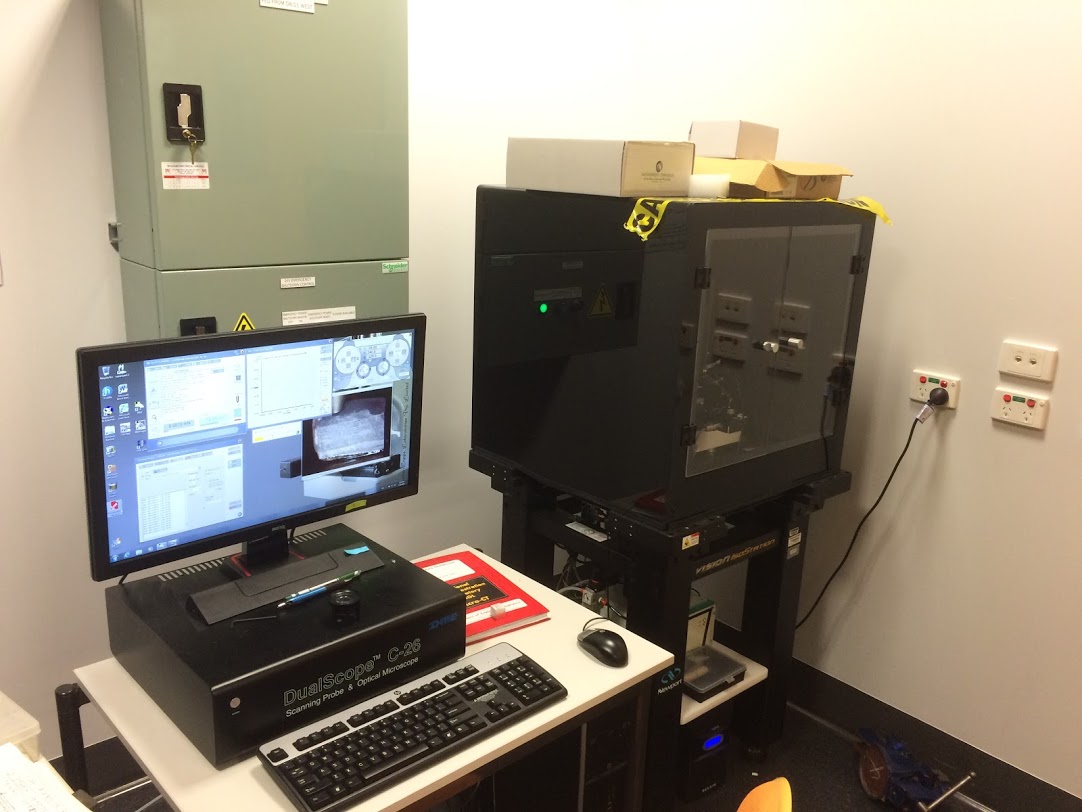
Quantitative microstructure characterization from micro-CT and nano-indentation
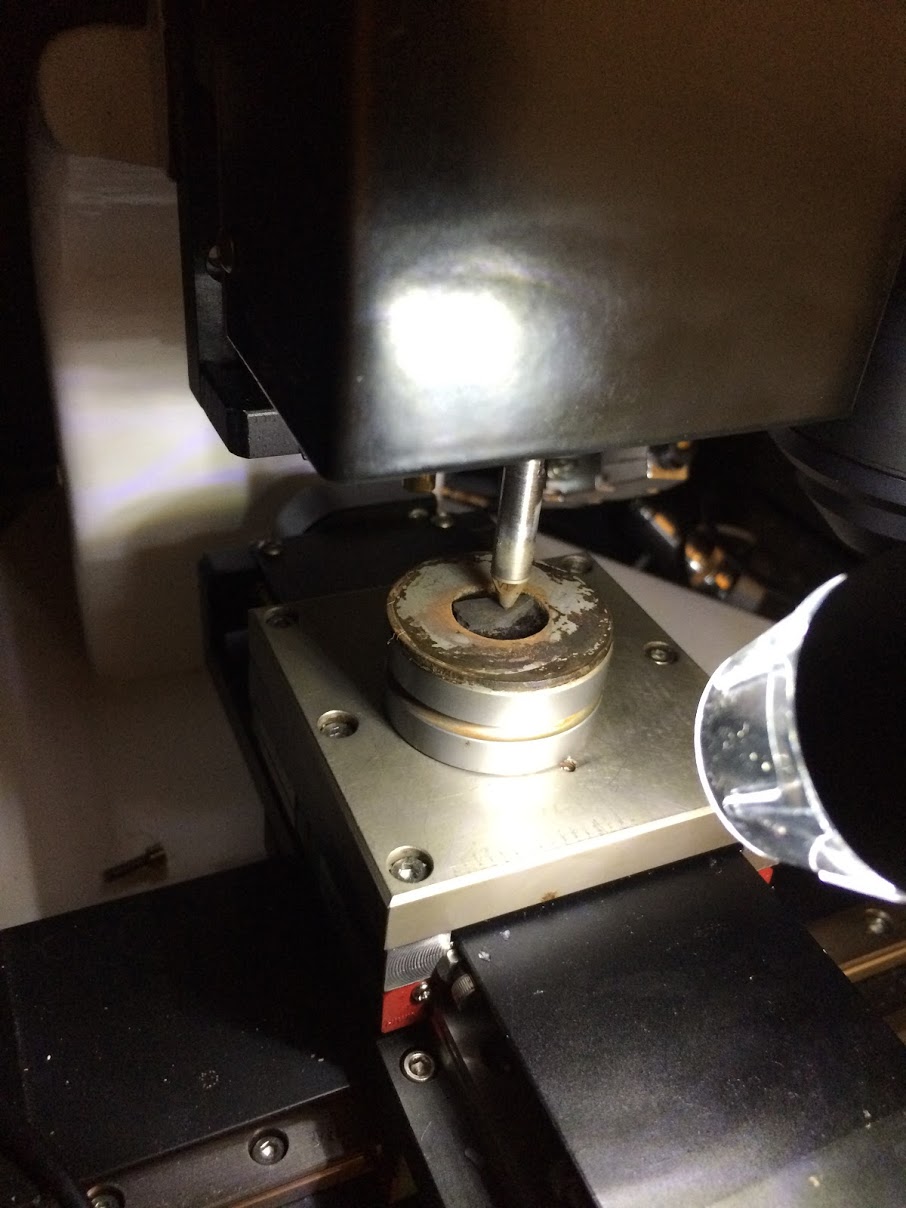
Quantitative microstructure characterization from micro-CT and nano-indentation
Laboratory measurements of intrinsic and stress-induced anisotropy
Determination of anisotropy in rock core is important to calibrate seismic data and validate theoretical rock models. Laboratory measurements using ultrasonic waves have large uncertainties due to relatively large transducer sizes and too few propagation directions available in typical laboratory configurations. To overcome these issues, CRGC has pioneered the use of a Laser Doppler interferometer (LDI) to measure displacement on the sample surface that results from wave propagation in the core.
LDI can measure the particle velocity of a small (0.01 mm2) element of the sample’s surface along the direction of the laser beam. By measuring the particle velocity of the same surface element in three independent directions and transforming them to Cartesian coordinates, we can obtain three components of the particle velocity vector. Therefore, LDI can be used as a localised three-component (3C) receiver of acoustic waves, and, together with a piezoelectric transducer or a pulsed laser as a source, can simulate a 3C seismic experiment in the laboratory.
Performing such 3C measurements at various locations on the sample’s surface produces a 3C seismogram, which can be used to separate P and two S waves, and to find polarisations and traveltimes of these waves. A ‘walk away’ laboratory experiment demonstrates high accuracy of the method. The measured data matches very well with the results from analytical modelling. From our results, we can conclude that it is possible to characterise elastic properties of materials from the described measurements. In particular, we are able to determine: 1) the angle between the particle movement and the direction of the wave propagation, i.e. the polarisation; 2) the type of waves; and 3) the arrival times of the wave at the point and thus the wave velocities.
Researchers: Prof. Maxim Lebedev, Prof. Boris Gurevich, Prof Andrej Bona
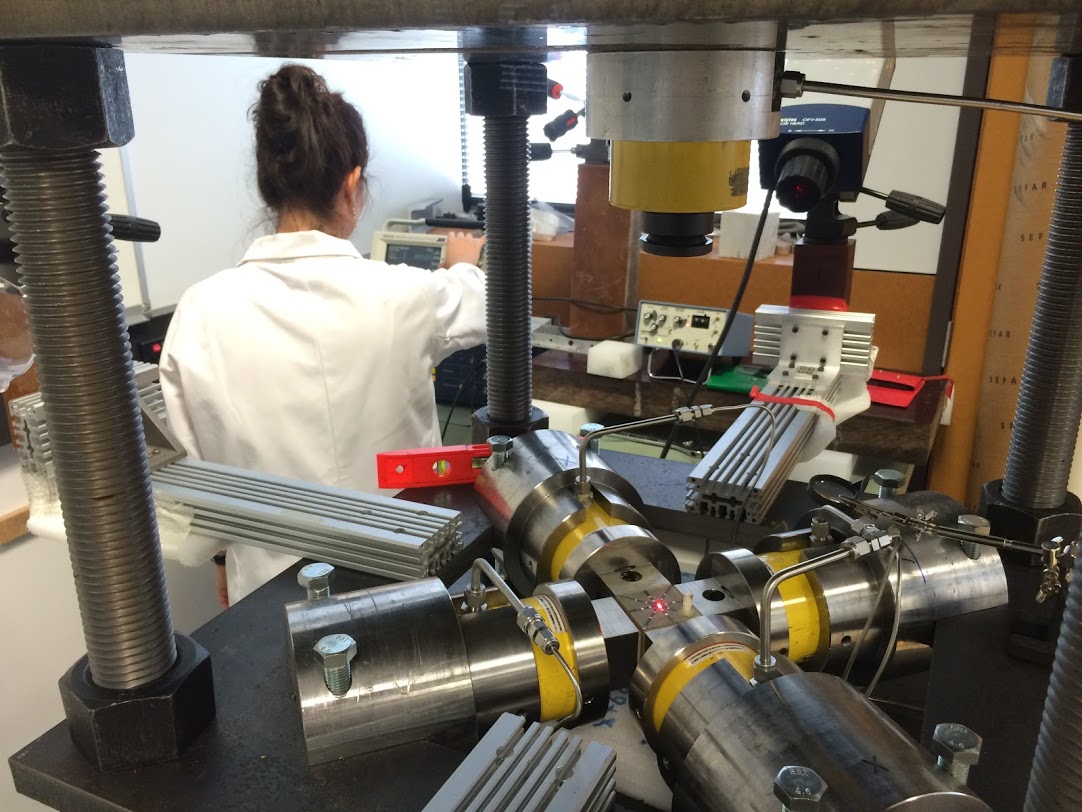
Laboratory measurements of intrinsic and stress-induced anisotropy
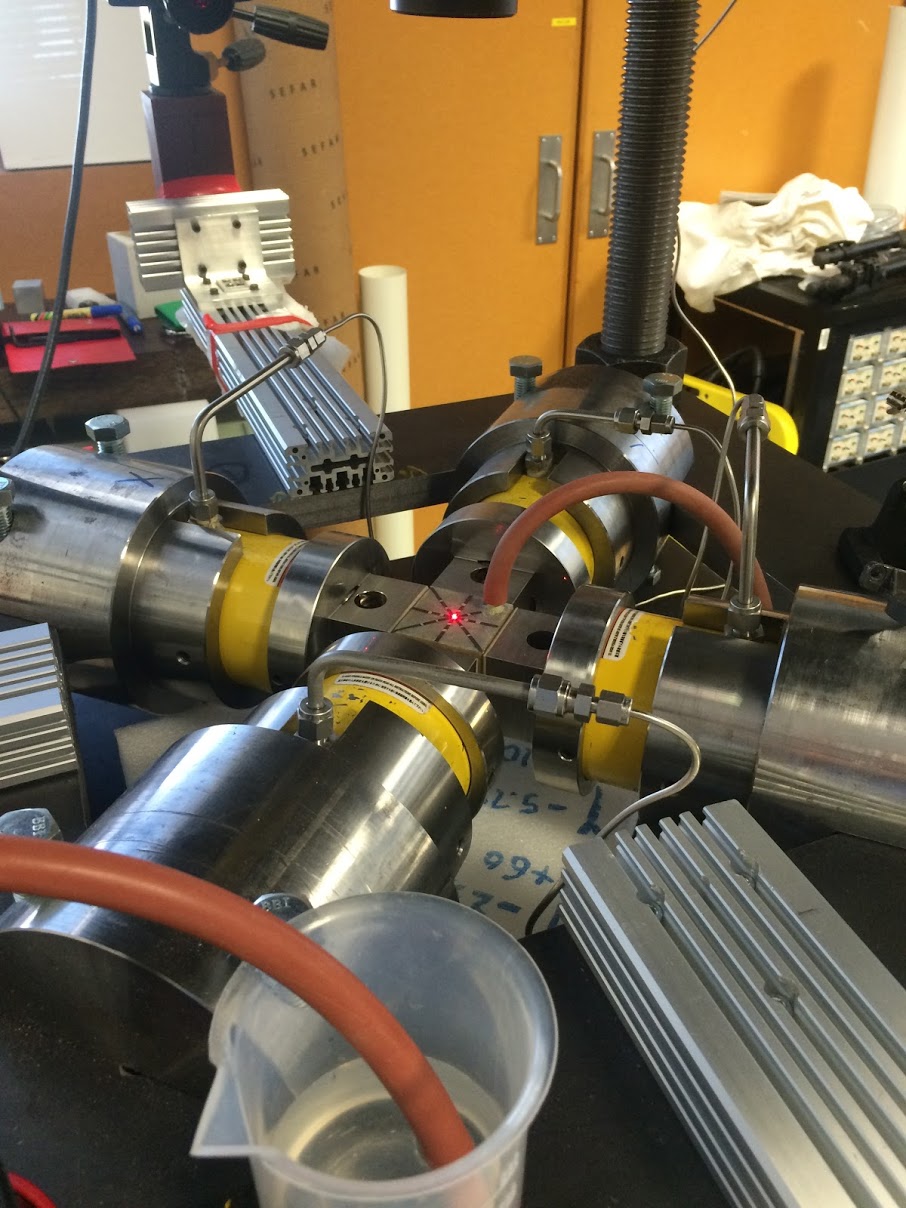
Laboratory measurements of intrinsic and stress-induced anisotropy
Digital rock physics under stress
Modelling physical properties of rocks based on microstructure derived from X-ray microtomographic images (known as digital rock physics) is an important technology in geophysical rock characterisation. However, these images are most commonly obtained at room pressure and temperature conditions. Consequently, most digital rock physics models are not representative of the rocks at depth. CRGC has developed methods to obtain X-ray microtomographic images under high pressure and temperature conditions. This results in more realistic pore network structures and fluid distributions.
Reservoir rocks are at such depth that they experience high stresses and temperatures. The thermodynamic properties of the fluids inside the reservoir are pressure and temperature dependent, therefore transport properties are also temperature and pressure dependent. Moreover, it is well established that elastic rock properties of rocks are strongly affected by stress and/or fluid distribution. Thus, in order to acquire realistic pore network structures and fluid distributions (including but not limited to residual saturation), and to reliably estimate transport and elastic properties from micro images, rocks with fluids inside have to be imaged at reservoir pressure and temperature conditions.
We have developed X-ray transparent pressure and temperature (P-T) cells capable of holding 5 mm to 38.5 mm diameter samples. The P-T cells are mounted inside a high-resolution 3D X-ray microscope VersaXRM-500 (XRadia-Zeiss), and 3D images with nominal voxel size resolutions from (0.3 μm)3 to (40 μm)3. The sample imaging is performed at stress levels up to 50 MPa and temperatures up to 60°C.
Researchers: Prof. Maxim Lebedev, Dr. Stephanie Vialle, Dr. Vassili Mikhaltsevitch
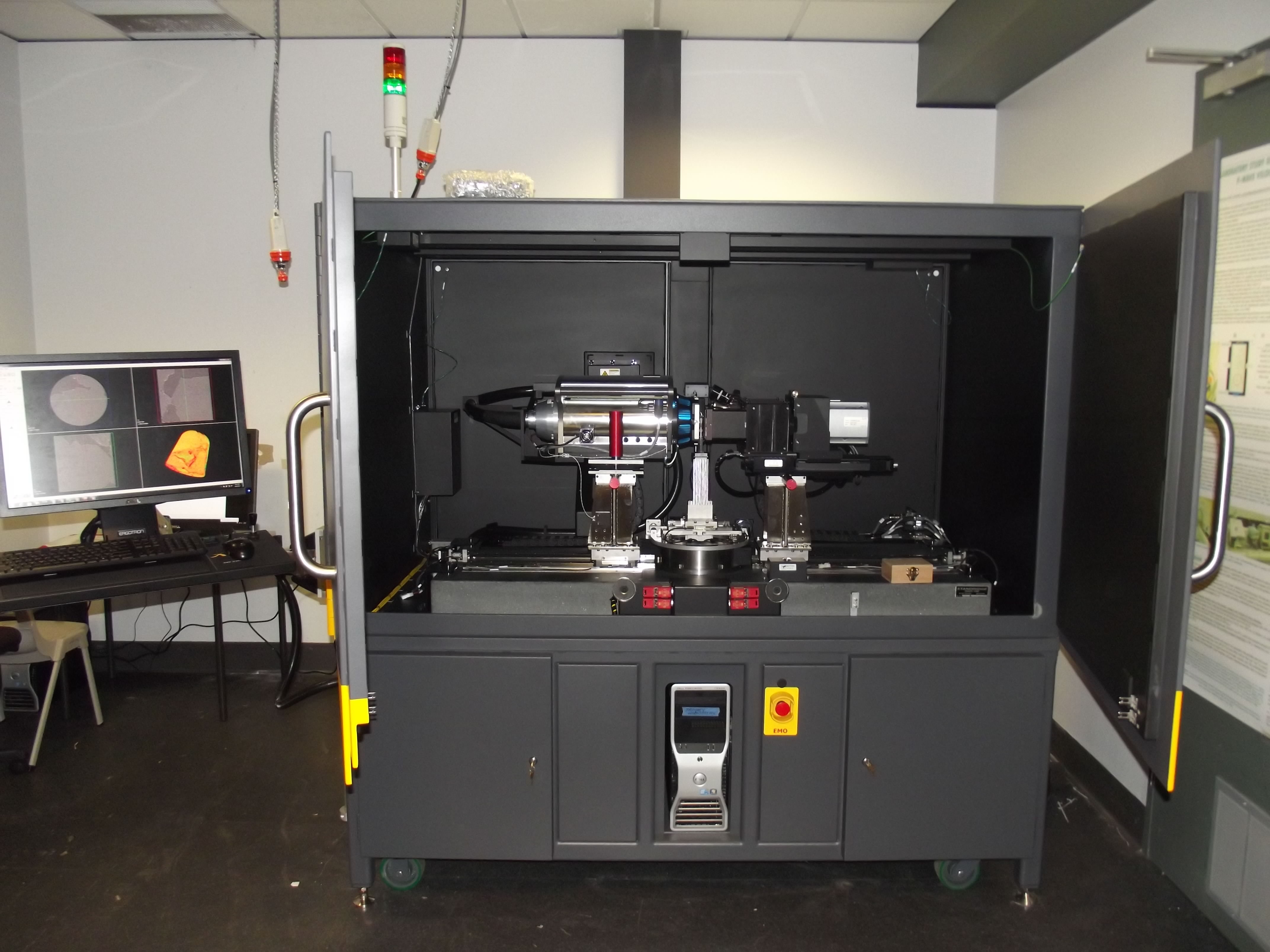
Digital rock physics under stress
Compaction behaviour of clay sediments
Understanding the elastic and hydraulic properties of shales is essential for pore pressure prediction and for characterising shale reservoirs and source rocks. These properties are strongly affected by shale compaction over geologic time. CRGC research seeks to better understand mechanical compaction – how initially unconsolidated sediments lose water and porosity and how that process affects geophysical parameters.
Mechanical compaction–one of the main rock-forming processes–occurs in the upper parts of the sedimentary basins, where the weight of overlying deposits compacts sediments below. During this process, sediments experience significant changes in microstructure and become stiff rock with different physical properties.
In this experimental work, we study how changes in microstructures affect elastic and transport properties of quartz-kaolinite-smectite mixtures during mechanical compaction. Uniaxial stress is applied to the samples progressively to achieve distinct levels of porosity, at which transit times of ultrasonic P- and S-waves in the samples are measured. Velocities and anisotropy parameters are then calculated. The microstructure of the samples is characterised by micro-CT data and SEM image analysis, as well as neutron diffraction experiment and compared with microstructures of real shales.
Researchers: Prof. Maxim Lebedev, Dr. Vassili Mikhaltsevitch
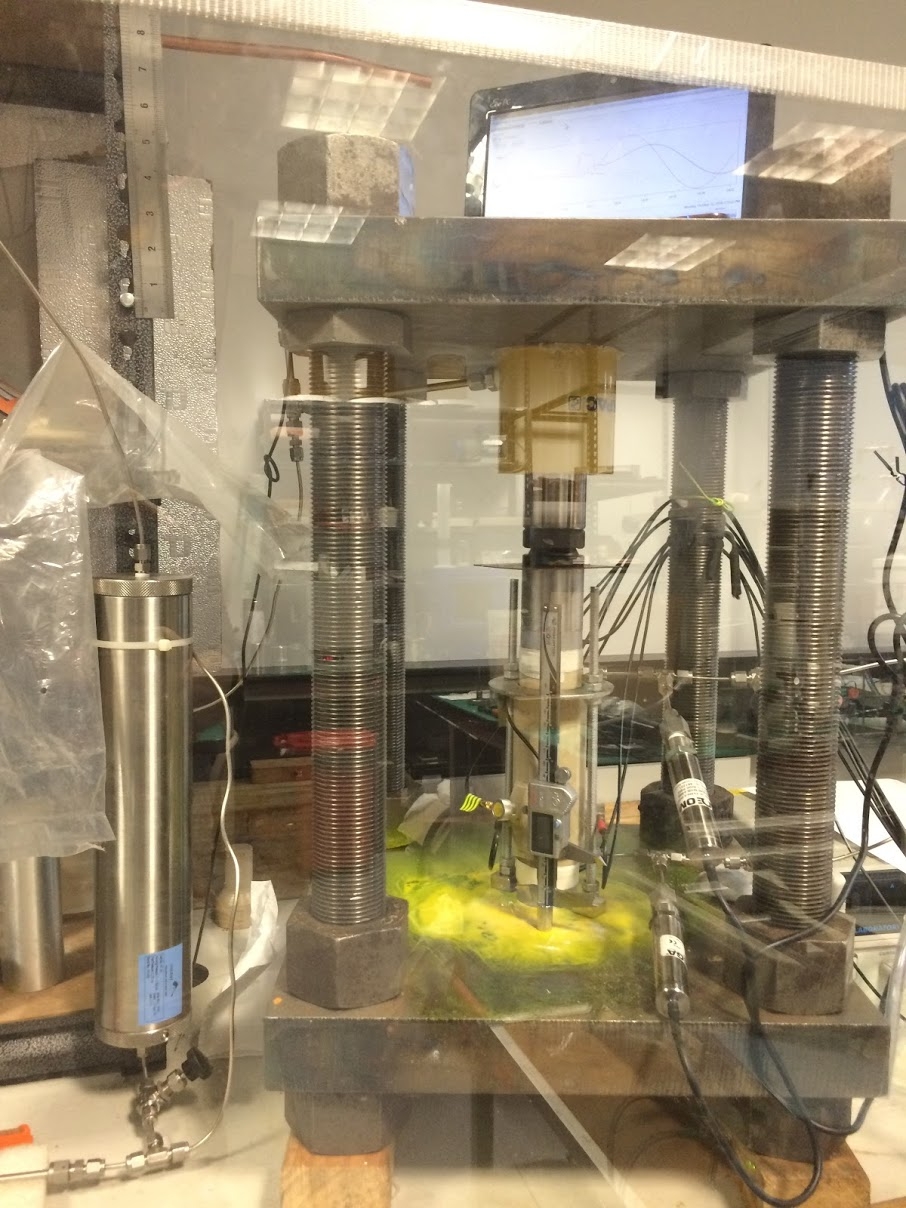
Compaction behaviour of clay sediments
Experimental and theoretical study of the effect of air humidity on room-dry velocities.
Reservoir characterisation using seismic data requires calibration using laboratory measurements. To avoid the effects of frequency dispersion associated with fluids, ultrasonic measurements are often made on dry samples, usually at room conditions. However, the results of such measurements can strongly depend on the air humidity. CRGC has developed laboratory capabilities and rock physics models in order to better understand the impact of rock sample hydration on the elastic properties.
The adsorption of water between clay particles in shales and quartz grains in sandstones leads to elastic weakening of the rocks. We have developed the laboratory facilities to study the effect of varying hydration on the elastic properties of rocks. Hydration of rock samples is changed using sorption processes by maintaining the samples in an atmosphere with controlled air humidity. The stress-dependent elastic properties of the samples at different hydration states are measured using the ultrasonic testing technique. The measurements of the elastic properties are complemented with the characterisation of changes in microstructure and concurrent deformation using X-Ray micro-CT and strain gauge measurements.
A number of rock physics theories is applied to the laboratory data to understand the driving mechanisms of the elastic weakening phenomenon. The theoretical research includes the study of the dependencies of the elastic properties of rocks on 1) the composition of the rock and the pore-filling fluid, 2) the stress-dependent compliant porosity, and 3) the orientation of pores and particles. These dependencies are modelled with the effective media theories, the Sayers-Kachanov non-interactive approximation, the orientation-distribution function data, and other rock physics theories and methods.
The results have the potential to improve interpretation of the near-surface seismic data as well as seismic and well-log characterisation of shaly formations.
Researchers: Prof. Maxim Lebedev, Prof. Boris Gurevich
Practical digital rock physics (DRP) workflow for predicting elastic moduli of rocks from micro-tomographic images
Rock physics models employed in subsurface characterisation from seismic data usually assume highly idealized rock microstructures and requires calibration to laboratory and/or well logging data. However, the best-fit model parameters obtained from such calibration often have little to do with real geometry of the pore space and minerals stiffness. Yet, microstructural effects of various geological processes (for instance, diagenetic changes, effect of compaction) are often reasonably well understood.
Modelling effective properties of rocks from 3D microtomographic images (known as digital rock physics or DRP) has the potential to bring together geological and rock physical approaches to rocks characterization. Successful examples of DRP modelling of rock stiffness are limited to simple, often, artificial samples, because the digital images are often too small and lack resolution to characterize real rocks. We propose a practical DRP workflow for somewhat more complex and ubiquitous rocks, namely, sandstones that contain mostly quartz and a small fraction of dispersed clay (known as arenites or clean arenites). Based on a set of images and lab measurements, we obtain a suite of post-computation corrections to compensate for the effects of sample size and resolution of the micro-CT images. The main result of the study is a segmentation workflow that effectively detects feldspar and clay minerals, despite their visual similarity to quartz in the images.
The moduli-porosity trend is derived from the subsamples of the original digital images. The bulk moduli agree well with the ultrasonic measurements on the dry samples at 40MPa, where the effect of unresolved compliant pores is minimal. The shear modulus remains overestimated. The discrepancy is likely caused by poor knowledge of the mineral stiffness. We compensate for this affect using a heuristic correction to the matrix moduli. The current version of the workflow provides accurate elastic moduli trends with porosity and clay content based on only two samples of Bentheimer sandstone.
To be robust this workflow requires further calibration and application to other rocks. This is the plan for the next phase of the project.
Researchers: Glubokovskikh, B. Gurevich, S. Vialle, M. Lebedev, J. Liang
Rock physics models informed by petrographic information (XRD etc)
Rock physics models are widely used for reservoir characterisation from seismic data. However, because of variability of rock geologic histories, structures and textures, most rock physics models always contain a number of parameters (such as pore aspect ratios, coordination numbers etc.), which are usually adjusted to a particular dataset. This limits the predictive power of these models. The objective of this study is to build a workflow where, all or most of the parameters will be obtained from a rich set of independent petrographic and petrophysical information. This study will be done using a well in a clastic reservoir with variable degree of cementation and a good set of well logs, petrographic description, thin sections and core samples available for measurements.
Researchers: S. Glubokovskikh., B. Gurevich, S. Vialle, M. Lebedev, J. Liang
Comparison of drained versus dry moduli using forced oscillation experiments
Rock physics transforms for reservoir characterisation are commonly calibrated using ultrasonic measurements. Since ultrasonic properties of fluid saturated rocks may be different from those at seismic frequencies due to squirt-flow dispersion, the calibration is most commonly done using measurements on dry cores (corrected for fluid saturation using Gassmann’s theory). However, a number of observations show significant discrepancy between measured moduli and those predicted from dry moduli with Gassmann’s theory, even at high effective pressures, where squirt dispersion should be minimal. Such discrepancies may be a result of core alteration during drying, or non-mechanical fluid-rock interaction.
This effect can be explored by using quasi-static forced-oscillation stress-strain measurements. This technique can be used to measure dry moduli, but also drained moduli (by using a saturated rock with a fluid valve kept open). We will compare dry moduli against drained moduli measured on a sandstone sample saturated with a number of fluids (water, n-decane) at different levels of confining pressure.
Researchers: Mikhaltsevitch, M. Lebedev, B. Gurevich, S. Glubokovskikh
Benchmarking of forced oscillation measurements across three labs [Curtin, ANU (Canberra), ENS (Paris)]
Rock physics transforms for reservoir characterisation are commonly calibrated using ultrasonic measurements. Since ultrasonic properties of fluid saturated rocks may be different from those at seismic frequencies due to squirt-flow dispersion, the calibration is most commonly done using measurements on dry cores (corrected for fluid saturation using Gassmann’s theory). However, a number of observations show significant discrepancy between measured moduli and those predicted from dry moduli with Gassmann’s theory, even at high effective pressures, where squirt dispersion should be minimal. Such discrepancies may be a result of core alteration during drying, or non-mechanical fluid-rock interaction.
An alternative it to measure elastic properties at seismic frequencies using quasi-static forced-oscillation stress-strain measurements. However, these measurements are still not widely used in the industry and their accuracy and reliability is not well understood.
To address this issue, we are comparing three different approaches of stress-strain techniques for laboratory testing of reservoir samples:(a) Young’s modulus and Poisson’s ratio from axial stress-strain testing, (b) Bulk modulus measured by oscillation of the confining pressure, and (c) Shear modulus from torsional forced oscillation. The measurements were performed on matching samples from the same sandstone reservoir from an oil field in West Africa. The results show a steady increase in ultrasonic velocities and shear modulus of the dry specimen as a function of pressure, which suggests a progressive closure of the inter-granular contacts. An increase of the moduli (K and E) and Poisson’s ratio, consistent with Gassmann’s theory, is observed for the decane-saturated samples, suggesting that the measurements correspond to the undrained (saturated isobaric) conditions. The lack of such fluid-related stiffening for low-frequency measurements with dead volumes comparable with the pore volume of the specimen indicate partially drained conditions and highlight the critical role of experimental boundary conditions. Directly measured bulk and shear moduli are consistent with those derived from Young’s modulus and Poisson’s ratio. These results of the inter-laboratory testing using different measurement devices are consistent in terms of the effect of frequency and fluid saturation for the reservoir sandstone specimen. Such broad consistency illustrates the validity of stress-strain techniques and constitutes an important benchmarking on laboratory testing of the elastic properties of a porous medium.
Researchers: Mikhaltsevitch, M. Lebedev, B. Gurevich (in collaboration with ENS and ANU)
Workflow for assessment of feasibility of time-lapse monitoring using integration of geological modelling, flow simulations, rock physics, seismic forward modelling, and seismic noise analysis
Development of a seismic 4D monitoring program (e.g., for CO2 injection) requires an understanding of expected time-lapse (TL) seismic signals. Hence, before such an injection experiment is undertaken, we assessed the feasibility of seismic monitoring in a modeling study. Considering realistic gas distributions obtained from reservoir simulations, we analyse the influence of various factors (injection volume, time after injection, and realizations of the reservoir flow model) on the TL seismic signal. However, the applicability of seismic monitoring depends not only on the strength of the TL seismic signal but also on the noise level of the seismic data. Hence, to estimate the detectability of gas in the subsurface, we have developed a workflow that integrates actual data repeatability observed at the Otway test site into the seismic feasibility study. Although we observed differences between the considered scenarios, all of the scenarios indicate a high likelihood of successful plume detection with the observed noise level and surface 4D seismic acquisition geometry used in previous seismic surveys in the area. However, detection of a thin layer of gas spreading out from the edges of the main plume below the seal in all scenarios would be challenging for surface seismic monitoring.
To maximise the chances of detecting the low-amplitude time-lapse signal we optimise the current time-lapse processing workflow using synthetic datasets for the entire baseline and monitor surveys. The datasets are obtained by an elastic 3D finite-difference modelling for the actual field acquisition geometry and the most realistic model of the subsurface and distribution of elastic properties in the gas plume. This was done by building a full-earth static geological model of the Otway site with resolution typical for reservoirs in petroleum exploration. Distributions of the seismic properties were obtained from geostatistical interpolation between wells within the static model and flow simulations. The analysis of the synthetic datasets gives an estimate of the magnitude of the time-lapse signal and illustrates effects of the conventional processing procedures on the signal in the presence of the band limited random noise. We have found that the anticipated intensity of the time-lapse signal is comparable to the average intensity of the reflections observed within the target interval, and hence should be sufficient for the detection of the signal. We believe that the proposed modelling workflow is of methodological value since it provides a reliable basis for seismic feasibility studies and development of modelling-driven processing workflows.
Researchers: R. Pevzner, B. Gurevich, S. Glubokovskikh
Characterisation of a CO2 plume from 4D seismic data
Injection of CO2 or gas into brine-saturated reservoir rocks reduces their elastic moduli and thus changes the seismic response. However, estimation of the stiffness reduction and 3D plume morphology have large uncertainty for regular Signal-to-Noise Ratio (SNR) and amount of prior geological information. We have examined the accuracy of the time-lapse seismic inversion based on Stage 2C of the CO2CRC Otway Project, which was specifically designed to test the sensitivity of seismic monitoring. To this end, we have built a set of adequate subsurface models to optimise the inversion workflow and assess its capability. First, 1D stochastic simulations and analytical models are used to estimate the effects of imperfect repeatability and limited bandwidth of the seismic (SNR ≈ 4). Then, we test a prototype inversion workflow on a virtual seismic survey – full-scale time-lapse synthetic seismic produced by 3D FD simulations in a detailed full-earth model. This test shows that errors associated with approximate nature of the seismic inversion algorithm reduces SNR to 2.1. Furthermore, detectable thickness of the plume reduces to 10m when the plume is laterally finite. The key findings of the synthetic study help design the inversion workflow for the Otway field data. Inverted parameters of the CO2 plume agree well with independent measurements, including repeat pulsed-neutron logging, in- and above-zone pressure monitoring and borehole seismic. To extract the plume body from the noisy inversion output, we use a Neyman-Pearson detector augmented by a spatial connectivity constraint. The proposed extraction criterion is then employed to compare history-matched reservoir with the monitoring data. For the simulated CO2 distribution, the proposed workflow would detect 70% of the plume areal footprint. The missed samples correspond to thin parts of the plume with low saturation, and hence their effect on the estimated total mass of CO2 in the reservoir is minimal.
Researchers: S. Glubokovskikh, R. Pevzner, B. Gurevich
Applicability of Gassmann’s theory and patchy saturation theories to nano-porous media
Unconventional reservoirs such as shales and tight sands are nano-porous materials whose rock physics properties are poorly understood. In particular it is unclear if these materials can be described by poroelasticity theory. To explore applicability of known poroeleastic models to nano-porous materials, we analyse a number of datasets of ultrasonic measurements performed on an idealised nano-porous material known as Vycor glass. All these measurements were performed during imbibition and drainage experiments using a number of fluids, and show variation of the elastic moduli versus liquid saturation. The results for a fully saturated glass are approximately consistent with Gassmann’s equation. Variations of the moduli with liquid saturation appear to be broadly consistent with known patchy saturation models. The result suggest applicability of poroeleatic models to nano-porous media but further experiments are planned to validate these findings.
Researchers: B. Gurevich, M. Lebedev
Rigorous bounds for attenuation and dispersion in porous fluid-saturated rocks.
Fluid saturated rocks often exhibit seismic attenuation due to wave-induced fluid pressure relaxation between pores of different shapes and orientation. Just like for elastic multimineral porous rocks Hashin-Shtrikman bounds are useful for constraining their effective moduli, it would be useful to have rigorous bounds for attenuation. To this end, we derive explicit expressions for bounds on the effective bulk and shear moduli of mixture of an elastic solid and Newtonian fluid. Since in frequency domain the shear modulus of the Newtonian fluid is complex-valued, the effective mixture moduli are, in general, also complex-valued and hence the bounds are curves in the complex plane. From the general expressions for bounds of effective moduli of viscoelastic mixtures, we show that effective bulk and shear moduli of such mixtures must lie between the real axis and a semi-circle in the upper half-plane connecting formal lower and upper Hashin-Shtrikman bounds of the mixture of the solid and inviscid fluid of the same compressibility as the Newtonian fluid. Furthermore, we show that the bounds on the effective complex bulk and shear moduli of the mixture are optimal, that is, the moduli corresponding to any point on the bounding curves can be attained by the Hashin sphere assemblage penetrated by a random distribution of thin cracks. The results are applicable to a variety of solid/fluid mixtures such as fluid-saturated porous materials and particle suspensions.
Researchers: B. Gurevich, S. Glubokovskikh
Seismic signature of diagenesis and diagenesis alteration
After deposition, sediments undergo various physical and chemical changes during burial under the effects of temperature and pressure (diagenesis). These changes are accompanied by textural changes that affect rock stiffness and thus seismic attributes. Furthermore, injection of anthropogenic fluids and wastes (brine, CO2, etc.) can induce fluid-rock interactions, inducing further mineral and textural changes, and thus potentially changing rock elastic properties. CRGC has developed experimental, theoretical and computational capabilities to study these effects, with a focus on carbonate rocks.
The Rock Physics Laboratory is equipped with various cells that allow the injection of reactive fluids under controlled fluid chemistry, flow rate, temperature and pore and confining pressures. Hooke cells are equipped with P- and S-wave transducers, and enable monitoring of acoustic velocities under dry and saturated conditions. In-house PET cells, smaller in size but transparent to X-rays, are mounted in the 3D X-ray microscope VersaXRM-500 (XRadia-Zeiss) and can monitor changes in pore structure induced by fluid-rock interactions. On these small samples, changes in elastic properties can be studied by nano-indentation tests.
Close collaborations with the geochemistry team of the National Geosequestration Laboratory for fluid preparation and analyses and with various rock characterization facilities for detailed mineralogy and texture analysis (Optical Microscopy, Scanning Electron Microscopy, Mineral mapping, etc.), complement these studies.
On the computational side, we are developing digital rock physics workflows to estimate elastic properties of rocks from high resolution images of their pore space (thin sections, micro CT-images) at various diagenetic stages.
Researchers: S Vialle, M. Lebedev
Seismic signature of hydrothermal processes associated to ore genesis (or gold deposits)
In the majority of gold deposits of economic importance in Australia and worldwide, the ore is disseminated within the rock and represents only a minor volume fraction, not directly detectable by geophysical methods. However, this type of ore deposit is associated with faults and veins, and is hosted in a variety of metamorphic rocks that have undergone mineralogy and texture changes under the action of hydrothermal fluids, that transport the gold up faults.
With a combination of laboratory characterisations on whole core samples from local gold mines (bulk and grain density, P- and S-wave velocities, porosity, mineralogy mapping, various methods of texture analysis), rock physics analysis and 2D seismic forward modelling, we are trying to understand which parameters (mineralogy, texture, etc.) can give a seismic reflectivity high enough to be detectable in seismic data.
Seismic methods are more and more used in mineral exploration, occurring now at greater depths, because they are the methods that best combine depth and resolution. However, little has be done to understand the relationship between the mineralogy and texture of these rocks and their geophysical properties.
Researchers: S. Vialle, A. Bona
